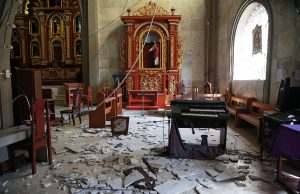
By Peter Blaza and Eloisa Lopez
PORAC, Philippines (Reuters) – Rescue teams in the Philippines searched for signs of life beneath the tangled debris from a collapsed four-storey commercial building on Tuesday after a strong earthquake shook the country’s biggest island, killing at least 16 people.
Heavy equipment and search dogs were used as dozens of firefighters, military and civilian rescuers shifted through mangled metal and lumps of concrete in Porac, a town 110 km (68 miles) north of Manila, where 12 people were killed by a 6.1 magnitude earthquake that struck on Monday.
Two people were rescued and carried out on stretchers on Tuesday, adding to seven found alive and four found dead overnight after higher levels caved in on a ground-floor supermarket in Porac, killing five people. Seven were killed elsewhere in the town.
Another, stronger earthquake with a magnitude of 6.5 struck in Samar island in the central Philippines on Tuesday afternoon, but there were no reports of injuries or major damage.
The national disaster agency said the Monday earthquake injured 81 people and damaged 29 buildings across Luzon island, with 14 people reported missing.
An investigation was underway into why the supermarket building collapsed so easily when most structures suffered only superficial damage from a quake that officials said was the biggest the town had ever felt.

Debris and rubble are pictured inside the Santa Catalina de Alejandria Parish after an earthquake the day before in Porac town, Pampanga province, Philippines, April 23, 2019. REUTERS/Eloisa Lopez
“We’re not sure how many people are trapped still,” Porac mayor Condralito dela Cruz told news channel ANC.
“We can still hear some voices, the voice of a woman.
The Philippines is prone to natural disasters and is located on the seismically active Pacific “Ring of Fire”, a horse shoe-shaped band of volcanoes and fault lines that arcs round the edge of the Pacific Ocean.
Aurelia Daeng, 65, was in her family drug store in Porac when Monday’s quake struck, breaking windows, cracking the floor and destroying one wall of her home.
“It was very strong. It was our first time experiencing something like that,” she said.
“This one, it’s terrifying.”
The earthquake was felt strongly in business areas of Manila, with residential and office buildings evacuated after being shaken for several minutes.
Train services were halted and roads and sidewalks were clogged by the sudden exodus of workers.
One corner of a 17th century church in Pampanga partially collapsed and the province’s international airport in Clark was closed for repairs. It was expected to reopen on Thursday at the latest, the transport minister said, adding there was no damage to the runway or control tower.
The government declared Tuesday a holiday for civil servants in Metro Manila to allow for safety inspections of buildings. Foreign exchange trading was suspended and a treasury bond auction canceled.
Irene Consultado, a government official, said many buildings were evacuated after Tuesday’s quake in Samar and early information indicated minor damage to infrastructure and commercial and residential properties.
(Additional reporting by Neil Jerome Morales and Karen Lema in MANILA; Writing by Martin Petty; Editing by Paul Tait, Robert Birsel)





